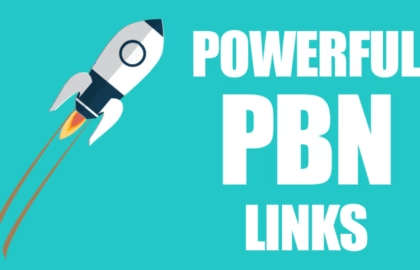PBN Links Search engine optimization (SEO) is a constantly evolving field, with various tactics emerging to gain an advantage over competitors. One controversial yet widely discussed strategy is the use of Private Blog Network (PBN) links. While PBNs have been effective in boosting rankings, they come with significant risks that can lead to penalties from search engines like Google. In this article, we will explore what PBN links are, their advantages and disadvantages, how they work, and best practices for minimizing risks.
What Are PBN Links?
A Private Blog Network (PBN) is a collection of websites that are owned or controlled by a single entity with the primary purpose of building backlinks to a target website. These backlinks are designed to manipulate search engine rankings by passing link equity (authority) to the main website. Since backlinks are one of the most crucial ranking factors in SEO, many website owners and SEO professionals use PBNs to improve their search rankings quickly.
How Do PBN Links Work?
PBNs operate by acquiring expired domains with strong existing backlinks. These domains are then repurposed to create blogs that link to the target website. Here’s a breakdown of how PBN links function:
- Domain Acquisition: SEO professionals purchase expired domains with a high Domain Authority (DA) or Domain Rating (DR) to leverage their existing backlink profiles.
- Website Setup: The acquired domains are set up as independent websites with unique designs and content to avoid detection.
- Content Creation: The PBN sites publish articles that include contextual links pointing to the target website.
- Link Placement: The links are placed naturally within the content to simulate organic linking.
- Indexing and Monitoring: The network is monitored to ensure that the links remain indexed and are not flagged by search engines.
Advantages of PBN Links
Despite the risks, many SEO professionals use PBN links because of their advantages:
1. Faster Rankings
PBNs allow website owners to control the quality and placement of backlinks, leading to faster ranking improvements compared to organic link-building methods.
2. Complete Control
Unlike outreach-based link building, PBNs offer full control over anchor text, link placement, and content context, allowing for a more strategic approach.
3. High Authority Links
Since PBNs are built on expired domains with strong backlink profiles, they can provide high-authority links that significantly boost rankings.
4. Reduced Dependency on Outreach
Link-building outreach can be time-consuming and expensive. PBNs eliminate the need to rely on other website owners for backlinks.
Risks and Disadvantages of PBN Links
While PBN links can provide short-term gains, they come with serious risks and downsides:
1. Google Penalties
Google strictly prohibits link schemes, including PBNs. If detected, your website may receive a manual penalty or be deindexed from search results.
2. High Maintenance Costs
Maintaining a PBN requires purchasing expired domains, hosting multiple sites, and regularly updating content, making it an expensive strategy.
3. Detection by Search Engines
Google’s algorithm is becoming increasingly sophisticated in detecting PBNs. If your network is identified, all associated sites may be penalized.
4. Not a Long-Term Strategy
SEO best practices emphasize organic growth and sustainable strategies. PBNs may work temporarily but are not viable for long-term success.
How to Minimize Risks When Using PBN Links
If you still choose to use PBN links, consider the following best practices to reduce the likelihood of detection and penalties:
1. Avoid Footprints
Ensure that your PBN sites do not share common characteristics that could make them easily identifiable. This includes using different hosting providers, unique WHOIS information, and varied website designs.
2. Use High-Quality Content
Create valuable, unique content for your PBN sites rather than using spun or duplicate content. Well-written content can help make the network appear more legitimate.
3. Diversify Link Building Strategies
Do not rely solely on PBNs. Incorporate other link-building methods such as guest blogging, broken link building, and natural outreach.
4. Limit Link Placements
Avoid placing too many links from your PBN to your target website. Overuse of PBN links can raise red flags with search engines.
5. Gradual Implementation
Do not build too many PBN links at once. A sudden influx of backlinks can trigger search engine scrutiny.
6. Monitor Your PBN Network
Regularly check for deindexing, penalties, and fluctuations in rankings to identify potential issues early.
Ethical and White-Hat Alternatives to PBN Links
For long-term success in SEO, consider these ethical and white-hat alternatives:
1. Guest Blogging
Publishing high-quality guest posts on authoritative sites in your niche is an excellent way to gain legitimate backlinks.
2. Broken Link Building
Finding broken links on high-authority sites and offering your content as a replacement is a natural and ethical way to earn links.
3. Content Marketing
Creating valuable, shareable content that attracts natural backlinks is one of the best ways to build authority.
4. Digital PR
Reaching out to journalists, bloggers, and industry influencers for mentions and features can lead to high-quality backlinks.
5. Building Relationships
Networking with other website owners and influencers in your industry can lead to organic link opportunities.
Conclusion
PBN links remain a debated SEO strategy due to their effectiveness and risks. While they can provide quick ranking improvements, they come with substantial penalties if detected. Given the evolving nature of search engine algorithms, ethical link-building strategies remain the safest and most sustainable approach. Whether or not to use PBN links depends on your risk tolerance, resources, and long-term SEO goals.






